The Defense Systems Information Analysis Center (DSIAC) was tasked with determining different methods that have been employed to weaponize Group 1 and 2 unmanned aircraft systems (UAS). Through the review of open-source news articles and publications, DSIAC compiled various methods of mounting guns, launchers, and munitions to drones, as well as different efforts to advance loitering-munition technologies. While some of the technologies were either developed or funded by the U.S. military, many of the technologies and modifications come from either nations or nonstate actors actively engaged in modern warfare tactics overseas. The evolving small UAS (sUAS) technologies are used for precision strike, ground support, surveillance, and counter-UAS missions. A brief summary of recent modifications and platforms is also included in this report.
1.0 Introduction
UAS are classified into five groups according to their size, range, and speed. The varying sizes and ranges of different UAS platforms provide unique advantages and disadvantages to each group. The smaller Group 1 and 2 UAS platforms were of particular interest to the inquirer, due to their low cost and widespread availability. These platforms can be equipped with COTS sensors and can carry weaponized payloads [1]. The ability of UAS to carry weaponized payloads is the focus of this response report, including external weapons, such as a missile or gun, or if the UAS is used as a weapon itself, such as a kamikaze.
The inquirer was looking to understand and characterize the current state of technology regarding weapons employment on small UAS, i.e., those with a maximum gross takeoff weight of 55 lb or less. Specifically, the inquirer was interested in three types of weapons employed on UAS: mounted guns, ballistic weapons (drop a bomb/guided missile), and loitering munitions (“be the bomb”). Additional related areas that were of interest to the inquirer included existing commercial-off-the-shelf (COTS) products and those munitions (both ballistic and guided) that have been specifically designed for UAS deployment.
2.0 Weapons Mounted on UAS
While the Department of Defense has funded efforts for weaponized drones, the ability for private citizens to obtain small, commercial UAS has resulted in numerous innovations for weaponizing drones. Examples of these innovations include the firing of a handgun (2008), a mounted flamethrower (2015), and attaching an aerosol device (2015) [2].
However, the United States military is not the only organization worldwide that has considered militarizing UAS, especially the small and affordable COTS drones included in Group 1 UAS. Countries that have weaponized UAS for military efforts include China, Russia, Israel, UK, and Turkey, among others. More troubling is the use of weaponized drones by violent, nonstate actors such as the Islamic State (ISIS).
2.1 Guns
Duke Robotics, a Florida-based defense contractor started by Israel Defense Forces veterans, developed the TIKAD sniper drone and sold some to the Israeli military in 2017 [3]. That startup has since developed a multirotor sniper drone capable of accurately firing a wide array of weapons such as military assault rifles and grenade launchers. This firing capability is possible due to the lightweight, real-time, 6 degrees of freedom (DOF), 10-lb robotic gimbal, as shown in Figure 1. This gimbal can absorb the shock of the remote firing of the weapon [4, 5].
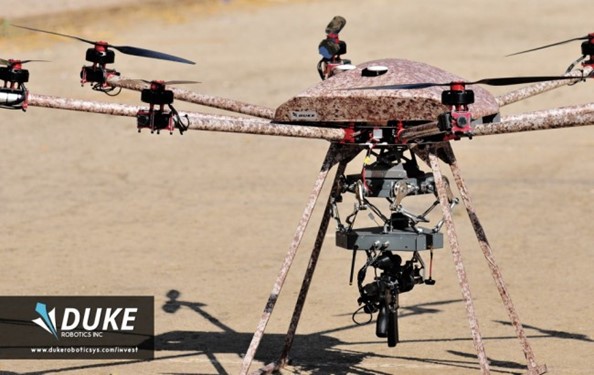
Figure 1: The Duke Robotics TIKAD Sniper Drone (Source: Duke Robotics [5]).
A shotgun has been mounted to a UAS, though this system appears designed to counter small, weaponized drones by blasting them out of the sky. Since the initial development of this UAS in 2016, the students at the Moscow Aviation Institute have now included a stabilizing mechanism to improve accuracy with the mounted Vepr-12 shotgun. The TIKAD has an endurance of approximately 40 min [6].
Turkey has unveiled the Songar drone, a small, tactical UAS that is armed with a light machine gun and designed to provide fire support for convoys or defensive positions at ranges up to 6 mi. The Songar drone is an eight-bladed rotorcraft built by the Turkish defense contractor Asisguard. It weighs 55 lb and can reach an altitude of 9,200 ft. It carries a modified 5.56-mm assault rifle that uses a linked feeding system to provide up to 200 rounds that can be fired as single shots or in 15-round bursts, as can be seen in the Popular Mechanics article [7].
A variant concept of the Songar drone shows a mounted gun and a 40-mm single-shot grenade launcher, which can be seen in the New Scientist article [8]. The drone features an automatic stabilized shooting system to stay locked on target while the gimble can traverse up to 60 degrees [7, 8].
2.2 Ballistics (Bombs or Guided Missiles)
In contrast to mounting guns to a UAS platform, another form of weaponizing drones is to arm them with bombs, grenades, or guided missiles.
Similar to the weaponized UAS discussed in Section 2.1.1, the Chinese Tianyi drone is a quadcopter developed by Tianjin Zhongwei Aerospace Data System Technology, which is armed with two 50-mm rockets with strike distances up to 1 km. The UAS has an operational distance of 5 km, vertical range of 6 km, and is designed to be controlled by soldiers on the ground [9].
The U.S. Army has selected the Raytheon Coyote drone for a near-term counter-UAS option. The small, expendable, tube-launched UAS will be equipped with an advanced seeker and warhead to identify and eliminate enemy threat UAS. The Coyote UAS can be flown individually or netted together in swarms, and it is adaptable for a variety of missions including surveillance, electronic warfare, and strike. The system will operate up to 1 hour and is designed for interchangeable payloads [10].
Dynetics developed an air-recoverable UAS platform for the Defense Advanced Research Projects Agency Gremlins program. The Gremlins will be launched from existing military aircraft, perform a mission, and be recovered by a C-130 transport aircraft. The platform’s architecture enables critical technologies such as advanced payloads, autonomous operations, and distributed battle management of swarming systems. This platform is expected to be able to quickly transition into multiple U.S. military applications [11].
The Velvet Wasp is a 12-kg (without batteries) drone with a carbon-fiber frame that was developed by UK defense contractor SteelRock (SR) Technologies and was debuted at the 2017 Dubai Air Show. It can travel at speeds up to 100 km/h using eight propellers and has a maximum endurance of over an hour, payload of 35+ kg, and telemetry range of 150 km from the base station. At the Dubai Air Show, the Velvet Wasp was displayed carrying the 13-lb Textron Fury precision-guided missile, as shown in Figure 2. However, it is now offered with the following payload options: Harris Hornet missile/supplies release system, a broad range of precision-guided munitions, or SR gravitational release parachute system [12, 13].
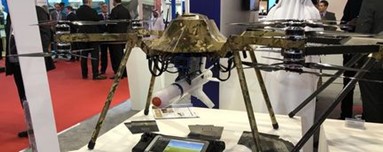
Figure 2: The SR-Developed Velvet Wasp Drone Carrying a Textron Fury Missile at the 2017 Dubai Air Show (Source: SteelRock Technologies [12]).
ISIS has modified UAS in multiple ways to perform drone attacks, using various UAS platforms and release mechanisms (ranging from dual, under-wing release to simple cup holders). In Figure 3, a drone is fitted with ordnance holders made from glue bottles. For many of the modified drones, the munition of choice appears to be 40-mm grenades.
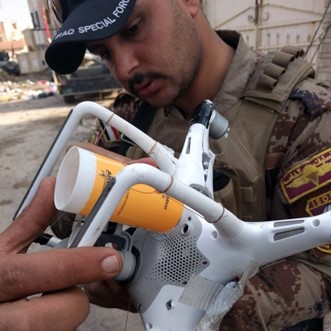
Figure 3: Basic Glue Bottle Ordnance Holder on a Captured IS Drone (Source: Mitch Utterback [14]).
ISIS released a propaganda video in January 2017 that showed other possible munition-laden drones that could be used in attacks. One such configuration had a Skywalker 8X drone with two bombs under-slung on the wings (Figure 4). These munitions were released using wire loops. Nick Waters, the author of the article that describes this IS drone, mentions that the munitions in the videos are most likely practice rounds [14].
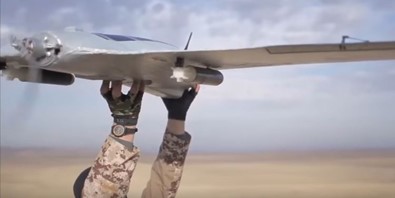
Figure 4: 8X Skywalker Drone with Two Munitions Under-Slung on its Wings (Source: Bellingcat [14]).
The Russian Army has plans to copy the IS by deploying small drones capable of swarming enemies and showering them with grenade-sized munitions. Russia is developing its own low-cost drones that can carry a 1-kg payload. Their plan is to be able to deliver the hand grenade-sized munition over long distances and with a precision that was previously lacking from overhead. Follow-on plans are to attempt developments with larger payloads [15]. Similarly, in their Tsentr-2019 wargame, Russia supposedly used a 15-kg Orlan-10 UAS in a test for drones to find and bomb targets with minimal human guidance. These UAS can carry a 6-kg payload, which in this case were air-dropped bombs or special guided missiles in small containers. However, outside analysts, including American Samuel Bendett (a research analyst with the Center for Naval Analyses’ International Affairs Group whose work involves Russian defense and security technology/development), question the ability of Orlan-10s to carry such payloads or to be flown without human controllers [16, 17].
As recently as March 2020, Group 1 UAS dropped 3-D printed mortars in Syria [18]. A collaboration between the United Arab Emirates’ International Golden Group and South Africa’s Rippel Effect Systems has developed two grenade launchers created for drone mounting, the DL3 and the DL6. The DL3 has three barrels and the DL6 has six barrels for launching 40-mm grenades, though it may be possible to retrofit the launchers for antidrone net grenades [19].
3.0 Loitering-Munition Drones
A loitering munition is a type of UAS designed to engage beyond line-of-sight ground targets with an explosive warhead. Loitering munitions are often portable and typically meant to provide ground units with a guided precision munition. They are equipped with high-resolution electro-optical and infrared cameras that enable the operator to locate, track, and guide the UAS to the target. A defining characteristic of loitering munitions is the ability to “loiter” in the air for an extended time before striking, giving the operator time to decide when and what to strike. Unlike other types of similarly sized UAS, loitering munitions detonate on impact and are not meant to be recovered, hence the nicknames “suicide” or “kamikaze” drones. The Center for the Study of the Drone at Bard College prepared a report in 2017 on loitering munition UAS, including the Raytheon Coyote and DARPA Gremlins systems that were discussed in Section 2.2 [20]. While the platforms mentioned previously can loiter before attacking and can be used as kamikaze drones, they may also be used in a recoverable fashion. Other systems that are listed by the developing organization as either loitering munitions or single-use drones are summarized in the following paragraphs.
Skyborne Technologies developed the tricopter Cerberus GL to compete in the loitering-munition space, though it is built to have weapons mounted to it and to be able to return to the operator for reloading with cost-effective ammunition. The Australian-developed drone can carry a range of payloads, including a single bomb; a mounted, 12-gauge shotgun; or a mounted, revolving grenade launcher with one or three 40-mm munitions [21−23]. The Cerberus GL weighs 6.5 kg and has a communications range of 3−5 km. The technology readiness level (TRL) 6 Cerberus GL single-shot, 40-mm prototype UAS, shown in Figure 5, has an endurance of 22 min [22, 23]. It was showcased in the U.S. Army Maneuver Battle Lab Army Expeditionary Warrior Experiment (AEWE) 2020 at Fort Benning at the end of 2019 (Figure 6) [22].
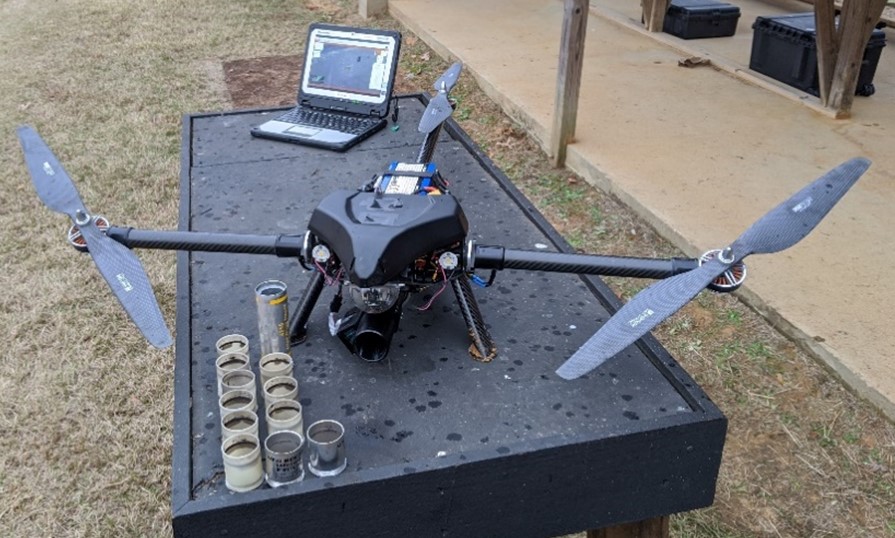
Figure 5: The Skyborne Technologies-Developed Cerberus GL (Source: Skyborne Technologies [22]).
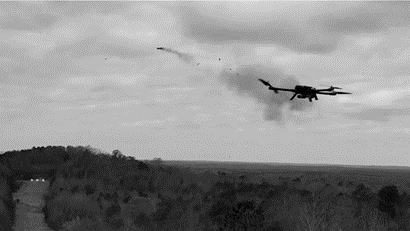
Figure 6: The Skyborne Technologies Cerberus GL performed at the U.S. Army Maneuver Battle Lab Army Expeditionary Warrior Experiment (AEWE) 2020 (Source: Skyborne Technologies [22]).
UVision fielded multiple variations of loitering suicide drones at the 2018 Association of the United States Army annual conference, including the 16.5-lb (including launcher and munition) Hero-30. The Hero-30 (Figure 7) is designed to give front-line troops the opportunity to locate, track, and attack targets with an airborne loiter time of 30 min. The small, antipersonnel warhead carried by the drone weighs a little more than 1 lb and is capable of destroying light-skinned vehicles, motorbikes, or troops in the open. The Hero-30 is a pneumatic-launch, low-noise, and low-thermal signature weapon system that is remotely operated and controlled. UVision’s Hero family of loitering-munition UAS includes Hero-20, Hero-30, Hero-70, Hero-120, Hero-250, Hero-400, Hero-400EC, Hero-900, and Hero-1250. The Hero-250 and smaller variants are Group 2 UAS [24, 25].
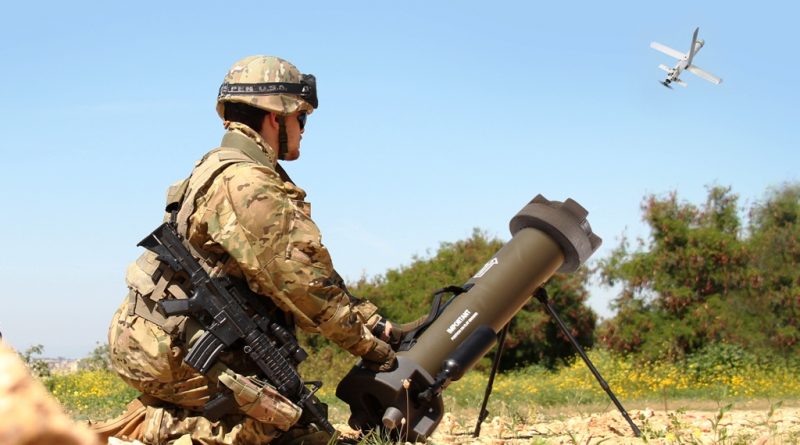
Figure 7: The Hero-30 Loitering-Munition Drone is Launched from a Pneumatic Tube (Source: UVision [24]).
AeroVironment’s class 1 loitering UAS system is the Switchblade 300 (Figure 8), which was developed originally for the U.S. Army and Marine Corps. The small UAS platform weighs about 5.5 lb and can be carried in a backpack. The Switchblade miniature lethal missile can be operated manually or autonomously for up to 15 min at ranges up to 10 km. The Switchblade’s explosive payload is a Northrop Grumman advanced munition [26, 27].

Figure 8: The AeroVironment Switchblade 300 Tactical Missile Platform (Source: AeroVironment).
In October 2020 AeroVironment unveiled their larger, class 3 Switchblade 600, which is equipped with a larger, antiarmor warhead. The Switchblade 600, shown in Figure 9, has an increased range of 40+ km, endurance of 40+ min, and dash speed of 115 mph. This newer model was originally developed for the U.S. Army’s Single Multi-Mission Attack Missile program, and AeroVironment will propose it for the U.S. Marine Corps Organic Precision Fires-Mounted program [28, 29]. AeroVironment says that they eventually plan to offer variants of both the 300 and 600 versions of the Switchblade with different mission payloads. They also plan to expand the Switchblade family as the power density of batteries available on the market increases [28].

Figure 9: The AeroVironment Switchblade 600 Tactical Missile Platform (Source: AeroVironment).
China has two loitering missiles, the CH-901 and WS-43, in its arsenal, which it intends to expand by purchasing two other types of loitering munitions. The CH-901 is 1.2 m long, weighs 9 kg, has a top speed of 150 km/h, an operation radius of 15 km, and an endurance of 120 min. The WS-43 is shot from a rocket launcher, carries a 20-kg warhead, has a 60-km range, and can loiter there for 30 min [30].
Israel Aerospace Industries (IAI) MBT missiles division developed the Harop loitering munition system over a decade ago. It is a successor to the Harpy UAS platform. The Harop is 2 m long, has a 3-m wingspan, and a 51-lb onboard explosive. While some systems carry a munition, the Harop itself is the main munition, and the munition system engagements can be executed, or can be aborted, using the controller. The UAS is driven by a propeller, has an operational range of 1,000 km, and can maneuver in the air for up to 6 hrs [31]. Israel’s Ministry of Defense has also procured the FireFly, shown in the C4ISRNet article [32], in collaboration with Rafael Advanced Defense Systems. The FireFly is a canister-deployed design with multiple rotors that weighs 400 gm and has almost twice as much explosive as an M67 fragmentation grenade. The system can travel up to 1,600 ft in an urban setting and nearly 3,300 ft in open terrain at 36 mph [32, 33].
In Russia, the Kalashnikov Group is producing a small, weaponized UAS called the KUB-BLA that explodes on impact. It is about 4 ft long and users can set coordinates for the strike manually or via the drone’s guidance system. It destroys targets with a 6-lb warhead. The noiseless, propeller-driven UAS has a range of about 40 mi and has “hidden launch” capabilities. The KUB-BLA may have been used in Syria by Russian forces where ISIS had launched some commercial-style drones with improvised explosive devices attached. In January 2018, Syrian opposition forces sent 13 small drones with explosive payloads to attack Russian bases in western Syria, which may have been inspiration for the suicide drone [34].
The Turkish security forces are set to receive 500 autonomous, tactical, multirotor UAS KARGU-2s, which were developed under a contract between the Defense Industry Presidency (SSB) and the Defense Technologies Engineering and Trade Inc. (STM). The KARGU-2 UAS is an updated version of the rotary-wing, kamikaze, mini-UAS KARGU that was added to the Turkish inventory in 2018. It can work autonomously or be controlled remotely and can perform tasks like abandonment or self-destruction, fuse-safe return, and target destruction from an adjustable distance. The KARGU-2 weighs 15 lb, has a top speed of approximately 90 mph, and has an endurance of about 30 min. The KARGU-2’s 3-lb warhead comes in three varieties: an explosive/fragmentation version for personnel or light vehicles, a thermobaric version to destroy buildings/bunkers, and a shaped charge for heavy armor. It is designed similarly to the Switchblade 300 but is able to safely return to the operator if no target is found [35, 36].
STM also manufactures the ALPAGU, which is a smaller, tube-launched, kamikaze, fixed-wing drone. The 1.9-kg drone has a 120-km/h maximum speed, 5-km operational range, and 10-min mission endurance [37].
The American company Anduril has developed a kinetic, counter-UAS, battering-ram drone called the Anvil. It is designed to destroy opposing UAS from below, with the battery and motors optimized for short, fast flights. Furthermore, the rotors are on its underside, helping to ensure that the drone survives encounters [38].
3.0 Conclusions
Various UAS platforms and modifications that are either on the market or in development for weaponizing drones were discussed in this report. Over the past 20 years, drones have become increasingly smaller, but increasingly more important on the battlefield. While in the previous decade, the battlefield was partially dominated by larger UAS like the General Atomics MQ-1 Predator and MQ-9 Reaper, the current trend is towards smaller Group 1 and 2 UAS that can switch payloads to perform a variety of missions: intelligence, surveillance, and reconnaissance (ISR); lethal attacks; or swarming maneuvers.
A current trend is outfitting Group 1 and 2 UAS with guns, though the recoil from machine guns and shotguns requires complex drone modifications. There are a few modified drones on the market or in development, but the more popular solutions appear to be to either attach a munition or transform the drone into the weapon. The Islamic State has modified COTS drones for years to drop simple munitions on enemy troops, a tactic that Russia seems to have adopted more recently in their recent skirmishes with Ukraine and Syria. Overall, however, the most popular current trend in drone warfare appears to be the development and use of loitering-munition UAS. Only a selection of the current loitering-munition drones of varying sizes and payloads were discussed here, and it appears that many of these will be improved in the coming years.
References
[1] Missile Defense Advocacy Alliance. “Unmanned Aircraft System (UAS) Basics.” https://missiledefenseadvocacy.org/missile-threat-and-proliferation/missile-basics/unmanned-aircraft-systems-uas/, accessed 12 June 2020.
[2] Rassler, D. “Remotely Piloted Innovation: Terrorism, Drones and Supportive Technology.” Combating Terrorism Center at West Point. https://ctc.usma.edu/wp-content/uploads/ 2016/10/Drones-Report.pdf, October 2016.
[3] Brown, D. “A U.S. Defense Contractor Developed a Drone That Can Fire a Sniper Rifle.” https://www.businessinsider.com/a-us-defense-contractor-developed-a-sniper-drone-that-could-save-lives-2017-8, 16 August 2017.
[4] Hsu, J. “Israeli Military Veterans Built a Sniper Drone.” Discover. https://www.discovermagazine.com/technology/israeli-military-veterans-built-a-sniper-drone, 18 August 2017.
[5] Duke Robotics. “No Boots on the Ground.” https://dukeroboticsys.com/, accessed 4 June 2020.
[6] Liptak, A. “Russia’s Shotgun-Firing Drone is Designed to Shoot Down Enemy Drones.” The Verge. https://www.theverge.com/2019/3/30/18287487/russia-shotgun-drone-counter-uav-syria, 30 March 2019.
[7] Mizokami, K. “Turkey’s New Drone Comes With a Machine Gun.” Popular Mechanics. https://www.popularmechanics.com/military/weapons/a30212669/turkey-machine-gun-drone/, 13 December 2019.
[8] Hambling, D. “Turkey Is Getting Military Drones Armed With Machine Guns.” New Scientist. https://www.newscientist.com/article/2227168-turkey-is-getting-military-drones-armed-with-machine-guns/, 12 December 2019.
[9] Zhen, L. “China Tests Killer Drones for Street-to-Street Urban Warfare, Plans Sales Overseas.” South China Morning Post. https://www.scmp.com/news/china/military/ article/3039827/chinese-tech-firm-testing-urban-attack-drone-designed-carry-out, 28 November 2019.
[10] Raytheon Missiles & Defense. “Coyote UAS.” https://www.raytheonmissiles anddefense.com/capabilities/products/coyote, accessed 14 May 2020.
[11] Dynetics. “The Gremlins Program Fact Sheet.” https://www.dynetics.com/_files/strike-systems/Dynetics%20Gremlins.v2.pdf, accessed 12 June 2020.
[12] Mizokami, K. “Military-Grade Killer Drones Are Starting to Hit the Market.” Popular Mechanics. https://www.popularmechanics.com/military/aviation/a13990354/military-grade-killer-drones-are-starting-to-hit-the-market/, 30 November 2017.
[13] SteelRock Technologies. “UAV Platforms.” https://www.acxodus.com/wp-content/ uploads/2019/03/SRT-UAV-Brochure-19.09.18.pdf, 19 September 2018.
[14] Waters, N. “Death from Above: The Drone Bombs of the Caliphate.” Bellingcat. https://www.bellingcat.com/news/mena/2017/02/10/death-drone-bombs-caliphate/, 10 February 2017.
[15] Mizokami, K. “The Russian Army Is Developing Killer Drone Swarms.” Popular Mechanics. https://www.popularmechanics.com/military/weapons/a28325831/russia-drone-swarm/,
8 July 2019.
[16] Tucker, P. “Russia Says It Used Autonomous Armed Strike Drones in a Wargame.” Defense One. https://www.defenseone.com/technology/2019/11/russia-were-testing-autonomous-armed-strike-drones-wargames/161187/, 8 November 2019.
[17] Ioanes, E. “Russia Wants to Arm Its Troops With Small Drones That Drop Bombs Because ISIS Did It.” Business Insider. https://www.businessinsider.com/russia-announced-it-would-give-military-small-drones-with-bombs-2019-7, 16 July 2019.
[18] Woody, C. “Drones Are Dropping Bombs on US Troops in Syria, and It’s Not Clear Who’s Doing It.” Business Insider. https://taskandpurpose.com/news/drones-bombing-us-troops-syria, 11 March 2020.
[19] Atherton, K. D. “Grenade Drones Progress From Improvised to Industry.” C4ISRNet. https://www.c4isrnet.com/unmanned/2019/02/20/grenade-launchers-for-drones-on-display-at-idex/, 20 February 2019.
[20] Gettinger, D., and A. H. Michel. “Loitering Munitions.” The Center for the Study of the Drone at Bard College. https://dronecenter.bard.edu/files/2017/02/CSD-Loitering-Munitions.pdf, February 2017.
[21] Atherton, K. D. “Grenade Launching Drone Will Be Part of Army Exercise in 2020.” C4ISRNet. https://www.c4isrnet.com/unmanned/2019/11/19/grenade-launcher-drone-is-backpackable-air-support/, 19 November 2019.
[22] Skyborne Technologies. “Cerberus GL.” https://www.skybornetech.com/cerberus-gl, accessed 20 January 2021.
[23] Skyborne Technologies. Personal communication, 20 January 2021.
[24] Rempfer, K. “Man-Packable Kamikaze Drones Offer Front-Line Tracking and Strike Passages.” Army Times. https://www.armytimes.com/news/your-army/2018/10/09/man-packable-kamikaze-drones-offer-front-line-tracking-and-strike-packages/, 9 October 2018.
[25] UVision Smart Loitering Systems. “Products.” https://uvisionuav.com/products/ #category_id_21, accessed 15 June 2020.
[26] AeroVironment. “Switchblade Loitering Missile.” https://www.avinc.com/images/uploads/ product_docs/Switchblade_300_FutureState_Datasheet_05142020%281%29.pdf, 14 May 2020.
[27] Army Technology. “Switchblade Tactical Missile System.” https://www.army-technology.com/projects/switchblade-tactical-missile-system/, accessed 16 June 2020.
[28] Reim, G. “AeroVironment Unveils Anti-Armour Switchblade 600 Loitering Munition.” Military UAVs. https://www.flightglobal.com/military-uavs/aerovironment-unveils-anti-armour-switchblade-600-loitering-munition/140409.article, 1 October 2020.
[29] AeroVironment. “Switchblade 600 Loitering Missile.” https://www.avinc.com/images/ uploads/product_docs/Switchblade_600_FutureState_Datasheet_11042020.pdf, 4 November 2020.
[30] DefenseWorld.net. “China to Buy 2 Types of Loitering Munitions.” https://www.defense world.net/news/26507/China_to_Buy_2_Types_of_Loitering_Munitions#.Xuq1hDpKiUk, 12 March 2020.
[31] Air Force Technology. “Harop Loitering Munitions UCAV System.” https://www.airforce-technology.com/projects/haroploiteringmuniti/, accessed 15 June 2020.
[32] Frantzman, S. J. “Israel Acquires Firefly Loitering Munition for Close Combat.” C4ISRNet. https://www.c4isrnet.com/unmanned/2020/05/05/israel-acquires-firefly-loitering-munition-for-close-combat/, 5 May 2020.
[33] Atherton, K. D. “Grenade Drone Promises an End to Cover, Forever.” Forbes. https://www.forbes.com/sites/kelseyatherton/2020/05/07/grenade-drone-promises-an-end-to-cover-forever/#27e59de841ea, 7 May 2020.
[34] Wheeler, A. “Drone Wars: Gremlins Versus the Kremlin.” Engineering.com. https://www.engineering.com/Hardware/ArticleID/18715/Drone-Wars-Gremlins-Versus-the-Kremlin.aspx, 8 March 2019.
[35] Daily Sabah. “Domestic Kamikaze Mini Drones Delivered to Turkish Security Forces.” https://www.dailysabah.com/defense/2020/01/31/domestic-kamikaze-mini-drones-delivered-to-turkish-security-forces, 31 January 2020.
[36] Hambling, D. “Turkish Military To Receive 500 Swarming Kamikaze Drones.” Forbes. https://www.forbes.com/sites/davidhambling/2020/06/17/turkish-military-to-receive-500-swarming-kamikaze-drones/?sh=1567a57a251a, 17 June 2020.
[37] STM. “ALPAGU.” https://www.stm.com.tr/en/alpagu, accessed 18 January 2020.
[38] Brandom, R. “Watch Anduril’s Anvil Take Down an Off-The-Shelf Drone in Midflight.” The Verge. https://www.theverge.com/2019/10/4/20898931/anduril-anvil-drone-footage-palmer-luckey-quadcopter, 4 October 2019.


